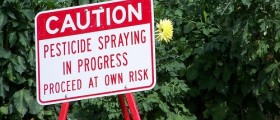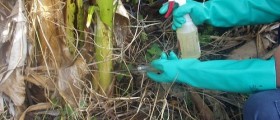
Overview
Pesticides are substances used to exterminate pests, organismsthat attack agriculture by feeding on crops. Pesticides are poisonous and canhave adverse effects on humans, but the exposure to those substances is in mostcases minimal. The main purpose of pesticides is to increase food production andprolong the life of stored crops. The pesticides keep weeds, insects andvarious other unfavorable agents from causing loss. The extent of dangerdepends on the degree of toxicity as well as the probability of exposure. The adverse health effects of pesticides rangefrom inducing cancer, hormonal imbalance, and dermatological issues to eyesproblems. In addition, if the benefits outweigh the risks the US Environmental ProtectionAgency will approve the utilization of certain pesticides. The two mainelements that the Agency takes into consideration are the group poisonouseffects of pesticides as well as the particular substances that cause harm ineach pesticide. The effects of the former are assessed for one time exposureto a group of pesticides with similar consequences. The EPA subsequently sets guidelines for theamount of pesticides which are allowed to be used as well as the frequency andmethods of employment. The EPA also provides plenty of useful information aboutthe types of pesticides that are particularly damaging and ways in which theyshould or should not be used via the National Pesticide Information Center. Basedon the degree of adversity, the Agency also proposed preventative measuresregarding the labeling of the pesticide, the tools which are necessaryfor their usage, and the type of protective gear to be worn when handlingpesticides.
Pesticides in Food Concerns
Many kinds of pesticides leave debris behind that is storedin the water or soil of the farm, and which relatively easily makes it onto thefoods. The reality, however, is that these substances have to be poisonous inorder to be useful, but it is also important that very small portions arerequired which create little or no adverse effects on animals, humans, and theenvironment. Although there have been numerous research studies investigatingthe effects of pesticides on humans, it is still difficult to estimate the longterm effects on health. It is therefore crucial that slightest possible amountof pesticides be utilized. The types of foods most likely to have pesticideresidue are fruits and vegetables, whereas juices, dairy products, and grains arerarely involved. Apples usually top all the lists as the number one producecontaining the most pesticide residue. In addition, there are various pointerson how to decrease the amount of toxic substances in the food. For instance,eating a wide range of fresh fruits and vegetables reduces the risk ofconsuming substantial quantities of one type of pesticide used on particularkind of product. It is also very beneficial to cook the food thoroughly todecrease the amount of pesticide residue. Washing and peeling should always becarried out and coupled with cooking. Anotherway to reduce the amount of pesticide residue on food is to buy organic, but itis important to note that growing organic food does not necessarily entail notutilizing pesticides at all, but in lesser amounts.
Health and Pesticides in Everyday Life
Pesticide use has been sparking debate for quite some time.Those who uphold it state that it is necessary in order to keep the cost offood production as low as possible while at the same time producing large quantitiesof produce. On the other hand, those who counter the usage of toxic substancesclaim that there hasn’t been enough research to support the fact that the costof food production would increase without pesticides simply because massive pesticidefree food production has never been tried. There are also many organizationswhich very publically oppose the use of pesticides due to public health risks,and who advocate raising awareness and taking action against pesticide usage inagriculture. However, small pesticide residue is less harmful than the toxic substancesleft on the crops by some insect or rodents. In many cases, foods will betested for pesticide residue as to ensure the guidelines were followed and noharmful effects will be transferred to those consuming the food or theenvironment in general. Both the federal and the state government can eliminateany foods that are found to contain amounts of pesticides that are higher thangranted. Also, imported foods, which make up for less than 10 percent of thefood supply in the United States, have to go through rigorous assessment beforeallowed on the market. Imported bananasare usually postulated to have high levels of pesticides, but regular carefulassessment has been showing otherwise. Thesituation is quite different with imported strawberries as they are not testedas regularly, and they have been known to actively exhibit higher than normalamounts of pesticide residue.








_f_280x120.jpg)








Your thoughts on this
Loading...